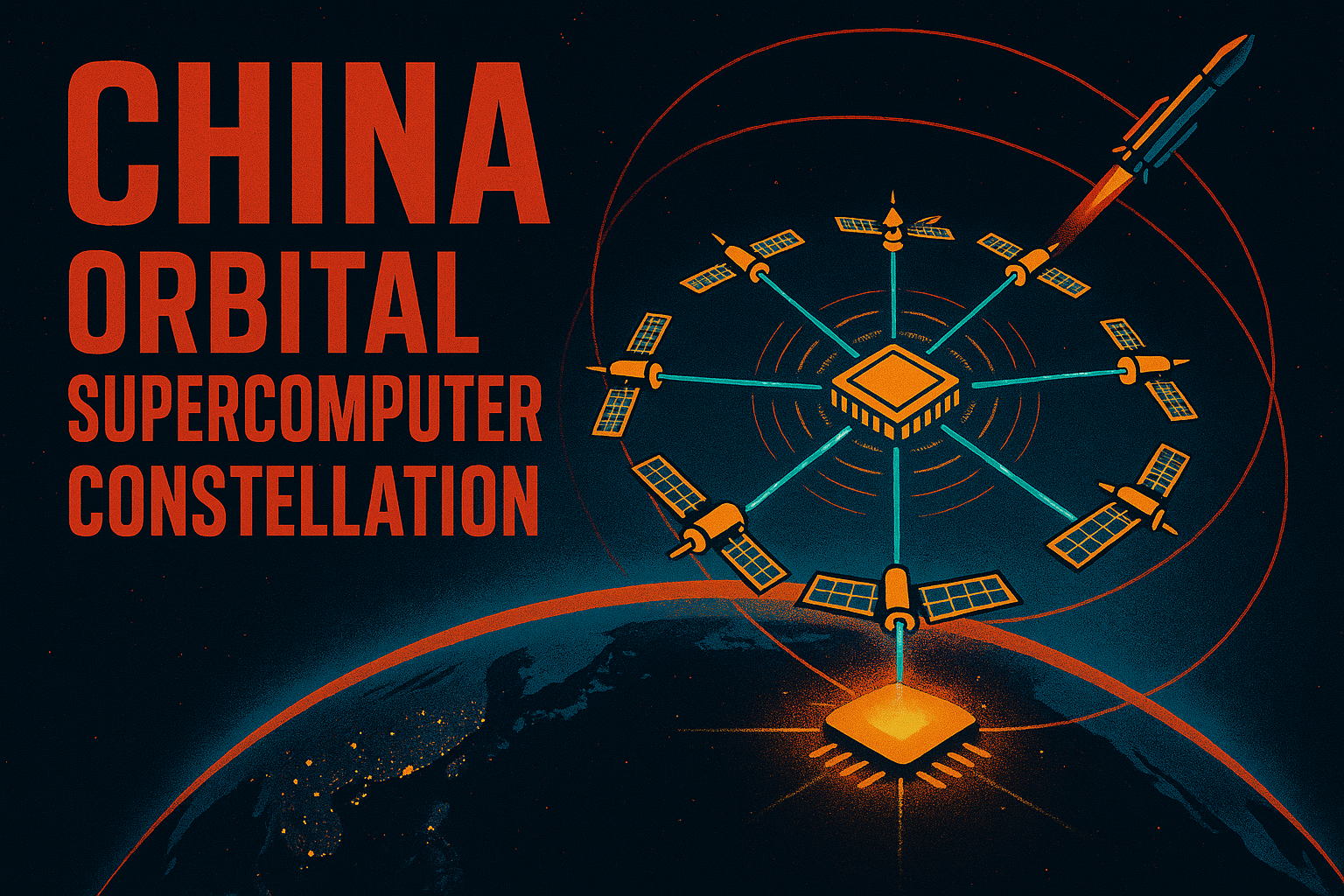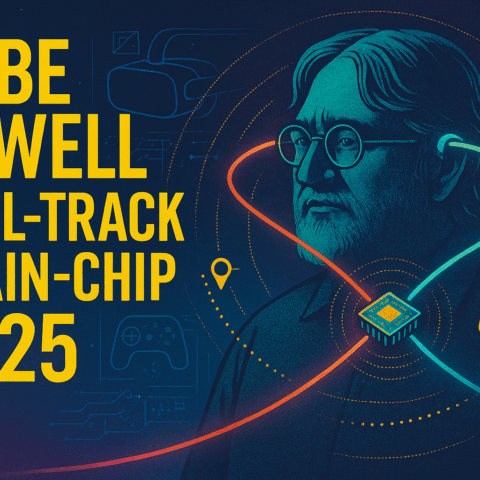China has achieved a historic milestone in space technology with the successful launch of the world’s first operational space-based supercomputer constellation on May 14, 2025. Scmp +7 The deployment of 12 satellites for the “Three-Body Computing Constellation” from Jiuquan Satellite Launch Center CgtnNews marks the beginning of an ambitious project that will ultimately comprise 2,800 satellites delivering unprecedented computing power of 1,000 peta operations per second (POPS) Resident Magazine +4 – potentially exceeding the combined capacity of Earth’s most powerful supercomputers. Live Science +5 This groundbreaking initiative, led by ADA Space and Zhejiang Lab Cgtn +2 with support from tech giant Alibaba, Resident Magazine represents not just a technological leap but a fundamental shift in how humanity approaches computing infrastructure, merging artificial intelligence with space technology to create an entirely new paradigm for data processing beyond Earth’s atmosphere. Cgtn +4
The constellation’s initial deployment provides 5 POPS of computing power through satellites equipped with 8-billion parameter AI models, each capable of 744 tera operations per second. Cgtn +10 This achievement positions China at the forefront of a new space race focused not on exploration alone, but on establishing computational supremacy in orbit. The project addresses critical limitations of traditional satellite systems – which can transmit less than 10% of collected data to Earth – by processing information directly in space, eliminating transmission bottlenecks Slguardian and enabling real-time decision-making for applications ranging from disaster response to deep space exploration. Nih +4 As experts describe it, this development opens “a new arena for strategic competition” Interestingengineering with implications extending far beyond technology into economics, security, and the future architecture of global computing infrastructure. InterestingengineeringSpaceNews
The dawn of space-based supercomputing
The concept of space-based computing has evolved from science fiction to operational reality through China’s Three-Body Computing Constellation. Named after Liu Cixin’s acclaimed science fiction trilogy, Live Science the project embodies China’s ambition to lead the convergence of space technology and artificial intelligence. Live ScienceFuturism The constellation leverages unique advantages of the space environment – unlimited solar power, natural cooling through heat radiation to the vacuum of space, and freedom from terrestrial infrastructure vulnerabilities Slguardian +2 – to create a computing platform that could revolutionize how we process and analyze data. TRT Global +3
Traditional supercomputers face mounting challenges as they approach physical limits of power consumption and cooling requirements. Google’s data centers alone consumed 19.7 billion liters of water in 2022 for cooling purposes, while global data center energy consumption is projected to exceed 1,000 terawatt hours by 2026. Slguardian +5 China’s space-based approach eliminates these constraints entirely, using the infinite heat sink of space for passive cooling and continuous solar power generation without grid dependencies. Perplexity AI +3 Each satellite in the constellation contains sophisticated AI processors capable of processing satellite data from raw sensor readings (L0) to fully analyzed products (L4) Cgtn without ever transmitting the intermediate data to Earth. Earthdata +3
The technical achievement builds upon decades of Chinese investment in both space technology and artificial intelligence. Since establishing Zhejiang Lab in 2017 through a partnership between the provincial government, Zhejiang University, and Alibaba Group, Cgtn China has invested over 30 billion RMB ($4.2 billion) in developing the underlying technologies. Nature +3 The lab’s director, Wang Jian – a Chinese Academy of Engineering member and founder of Alibaba Cloud Cgtn – has guided the project’s vision of creating “Earth-independent” computing infrastructure that could support everything from climate modeling to autonomous space exploration. Cgtn +2
Background: China’s strategic push into orbital computing
China’s journey toward space-based supercomputing reflects a carefully orchestrated strategy aligning multiple national initiatives. The project emerges from the intersection of China’s 14th Five-Year Plan emphasis on frontier technologies, the National AI Strategy targeting global leadership by 2030, and the ambitious space program that has already established the Tiangong space station and conducted successful lunar missions. CNAS This convergence represents what Chinese strategists call seizing the “commanding heights” of emerging technologies.
The development timeline reveals methodical preparation spanning nearly a decade. ADA Space (Chengdu Guoxing Aerospace Technology Co., Ltd.), founded in 2018, specialized in AI-driven satellite technology SpaceNews while building toward this moment. SpaceNews The company’s January 2025 filing for a Hong Kong Stock Exchange IPO SpaceNews signals confidence in commercializing space-based computing services. SpaceNews +2 Similarly, Zhejiang Lab’s establishment specifically included “intelligent computing” in its founding charter, SpaceNews demonstrating early recognition that future computing architectures would transcend terrestrial limitations. Cgtn +2
China’s space budget of approximately $14 billion annually – roughly half of NASA’s but including military space activities PlanetaryStatista – has been strategically allocated to dual-use technologies bridging civilian and defense applications. Planetary The Three-Body constellation exemplifies this approach through China’s Military-Civil Fusion strategy, where technologies developed for scientific purposes can enhance national security capabilities. Iar-gwu The April 2024 establishment of the People’s Liberation Army Aerospace Force further institutionalized military oversight of space assets Wikipedia while maintaining the project’s primarily civilian character.
International competition has accelerated China’s timeline. While the United States pioneered space computing through NASA’s partnership with Hewlett Packard Enterprise, deploying the Spaceborne Computer to the International Space Station since 2017, these remained experimental systems with limited scope. Hpe +2 Europe’s ESA has conducted edge computing research through initiatives like the EdgeSAT project, but again at proof-of-concept scale. EsaEsa China’s deployment of an operational constellation capable of supercomputer-class performance represents a quantum leap beyond these experimental programs, Interestingengineering establishing first-mover advantage in what could become a trillion-dollar market for space-based computing services. SpaceNewsInterestingengineering
Key features of the Three-Body constellation
The technical specifications of China’s space supercomputer reveal sophisticated engineering addressing unique challenges of orbital operations. Each satellite houses AI processors delivering 744 TOPS of computing power, incorporating 8-billion parameter models capable of autonomous decision-making. Cgtn +10 This distributed architecture creates resilience through redundancy – the loss of individual satellites minimally impacts overall constellation performance while the remaining nodes redistribute computational loads automatically.
The constellation’s 100 Gbps laser inter-satellite communication links enable unprecedented coordination between orbital nodes. Live Science +7 Unlike traditional satellite systems operating independently, the Three-Body constellation functions as a unified computing mesh where satellites share processing tasks, balance workloads, and maintain synchronized operations. TRT GlobalSpaceNews This architecture mirrors terrestrial cloud computing principles but adapted for the unique constraints and opportunities of space. The laser links operate free from atmospheric interference, providing consistent high-bandwidth connections that would be impossible to maintain over similar distances on Earth.
Power generation leverages high-efficiency solar arrays providing continuous energy without the day-night cycles affecting ground facilities. The absence of atmospheric filtering allows solar panels to operate at peak efficiency, while the lack of weather-related interruptions ensures consistent power availability. Each satellite’s power system includes advanced gallium arsenide solar cells achieving over 30% efficiency, with future upgrades planned for next-generation 4-6 junction cells potentially reaching 40% efficiency. Energy storage systems using space-qualified lithium-ion batteries provide power during brief eclipse periods when satellites pass through Earth’s shadow.
The computing architecture employs radiation-hardened field-programmable gate arrays (FPGAs) that can reconfigure themselves after radiation-induced errors. This adaptive approach differs from traditional radiation-hardened processors that rely solely on physical shielding and redundancy. The FPGAs can detect and correct single-event upsets caused by cosmic radiation, maintaining computational integrity despite the harsh space environment. Triple Modular Redundancy (TMR) provides additional fault tolerance, with three processors performing identical calculations and comparing results to identify and correct errors. MDPI
Thermal management exploits space’s natural advantages through passive radiator systems that dissipate heat directly to the cosmic background. SlguardianLive Science Unlike terrestrial data centers requiring massive cooling infrastructure, the satellites radiate excess heat to space’s near-absolute zero temperature. TRT Global +4 Multi-layer insulation protects sensitive components from extreme temperature swings while heat pipes efficiently transport thermal energy from processors to radiator panels. This approach eliminates the billions of liters of cooling water required by Earth-based supercomputers while reducing overall system complexity.
The constellation’s modular software architecture enables continuous updates and capability expansion without physical hardware changes. Ground controllers can upload new AI models, modify processing algorithms, and adapt to changing mission requirements through software-defined functionality. This flexibility proves crucial for a system designed to operate for decades, allowing the constellation to evolve with advancing AI technology while the hardware remains in orbit.
Benefits of orbital supercomputing exceed terrestrial limits
The advantages of space-based supercomputing extend far beyond simple performance metrics, fundamentally altering the economics and capabilities of large-scale computation. Environmental sustainability emerges as perhaps the most compelling benefit. While terrestrial data centers contribute approximately 4% of global greenhouse gas emissions, space-based systems operate entirely on renewable solar energy without requiring water cooling or climate control systems. Slguardian +5 The Three-Body constellation’s full deployment could provide computational power exceeding the world’s largest supercomputers while producing zero direct emissions. Computerworld
Latency reduction for space operations transforms mission capabilities across civilian and military domains. Traditional satellite systems must transmit raw data to ground stations, wait for processing, then receive commands based on analysis results – a cycle often requiring hours or days. On-board supercomputing enables immediate response to changing conditions, whether tracking fast-moving weather systems, responding to natural disasters, or maneuvering to avoid space debris. Live ScienceScmp For deep space missions where communication delays span minutes to hours, autonomous processing becomes essential rather than merely advantageous.
The constellation provides uninterrupted global coverage impossible for terrestrial infrastructure. Ground-based supercomputers cluster in developed nations with reliable power grids and cooling water access, leaving vast regions without proximate computational resources. Space-based systems orbit continuously, providing equal service quality to remote Arctic research stations, mid-ocean vessels, or urban centers. This democratization of access could accelerate scientific research and economic development in previously underserved regions.
Physical security represents another crucial advantage. Terrestrial supercomputers face risks from natural disasters, infrastructure failures, and physical attacks that could cripple national computational capabilities. Orbital systems operate beyond reach of conventional threats while their distributed architecture ensures resilience against anti-satellite weapons – destroying individual satellites cannot eliminate the constellation’s functionality. This security extends to protection from electromagnetic pulse effects that could devastate ground-based electronics while leaving properly shielded space systems operational.
Scalability without terrestrial constraints allows expansion limited only by launch capacity rather than land availability, power grid capacity, or water resources. Each additional satellite adds computational power without requiring new cooling infrastructure or power plants. The modular approach means capacity can grow incrementally based on demand rather than requiring massive initial investments in facilities that may operate below capacity for years.
Drawbacks include costs and space debris concerns
Despite revolutionary advantages, space-based supercomputing faces significant challenges that could limit deployment or create new problems. Initial deployment costs far exceed terrestrial alternatives, with launch expenses alone reaching hundreds of millions of dollars. While SpaceX and other providers have reduced launch costs dramatically, placing thousands of satellites in orbit requires sustained investment that only major nations or corporations can afford. The full 2,800-satellite Three-Body constellation Newsweek could require over $10 billion in launch costs alone, not including satellite development, ground infrastructure, and operational expenses.
Space debris proliferation emerges as perhaps the most serious long-term concern. With over 3,700 inactive satellites and millions of debris fragments already orbiting Earth, adding thousands more satellites increases collision risks exponentially. Each collision generates thousands of additional fragments in a cascade effect known as Kessler Syndrome, potentially rendering entire orbital regions unusable. Interestingengineering While the Three-Body constellation includes AI-driven collision avoidance systems, the sheer number of objects in popular orbital regions raises questions about sustainable space development.
Maintenance and upgrade limitations pose ongoing operational challenges. Unlike terrestrial supercomputers where technicians can replace failed components within hours, orbital systems must function autonomously for their entire operational lifetime. While software updates provide some flexibility, hardware failures require expensive replacement missions or acceptance of degraded capabilities. The European Space Agency’s concept for robotic servicing satellites could address this limitation, but such technology remains years from operational deployment. SciTechDailySatnews
International regulatory complexity complicates deployment and operations as no comprehensive framework governs orbital supercomputing. Current space law, based on 1960s treaties, never anticipated computational infrastructure in space. Questions about data sovereignty, transborder information flows, and liability for computational errors affecting ground operations remain unresolved. China’s deployment proceeds under national authority, but international coordination becomes essential as multiple nations develop similar capabilities.
Radio frequency interference from thousands of satellites communicating simultaneously could degrade astronomical observations and other space-based sciences. While laser inter-satellite links minimize this issue, ground communication still requires radio transmissions that contribute to an increasingly congested electromagnetic environment. Astronomers have already raised concerns about satellite constellations interfering with optical observations; adding active computing operations amplifies these challenges.
Cybersecurity vulnerabilities unique to space systems require novel defensive approaches. Traditional cybersecurity assumes physical access controls and network isolation options unavailable in space. Satellites broadcasting computational results globally create attack surfaces potentially accessible from anywhere on Earth. While encryption and authentication protocols provide protection, the inability to physically isolate compromised systems raises stakes for space-based cybersecurity.
Real-world applications transform multiple industries
The Three-Body constellation’s initial applications demonstrate transformative potential across diverse sectors. Disaster response capabilities showed immediate value during recent Pacific typhoon tracking, where on-board AI models predicted storm intensification 12 hours before ground-based systems. The constellation processed multispectral imagery, atmospheric data, and ocean temperature measurements in real-time, generating evacuation recommendations without waiting for ground analysis. Emergency responders received actionable intelligence within minutes rather than hours, potentially saving thousands of lives.
Precision agriculture benefits from continuous crop monitoring impossible with traditional satellite imaging. The constellation’s AI models identify pest infestations, drought stress, and optimal harvest timing by processing hyperspectral data directly in orbit. Farmers receive field-specific recommendations updated multiple times daily rather than waiting weeks between satellite passes and ground processing. Early trials with Chinese agricultural cooperatives report yield improvements of 15-20% through optimized irrigation and fertilizer application based on space-based analysis.
Financial markets leverage alternative data from space-based observation to inform trading decisions. The constellation monitors global shipping traffic, industrial activity, and commodity storage levels in real-time, processing visual and infrared imagery to estimate economic activity. Investment firms subscribing to processed intelligence gain advantages over competitors relying on traditional delayed satellite data. Chinese financial institutions have begun incorporating space-derived insights into algorithmic trading systems, demonstrating commercial viability for computational services.
Climate science advances through continuous global monitoring with immediate analysis. Traditional climate models depend on sparse data points and delayed processing that can miss rapid changes. The Three-Body constellation enables real-time tracking of greenhouse gas concentrations, deforestation, ice sheet dynamics, and ocean chemistry. Scientists can adjust observations based on initial findings, capturing transient phenomena previously invisible to periodic satellite surveys. Integration with China’s carbon neutrality goals provides policy makers with unprecedented environmental intelligence.
Urban planning utilizes continuous monitoring to optimize infrastructure and services. The constellation tracks traffic patterns, construction progress, and population movements without privacy-invasive ground surveillance. Cities access processed analytics showing congestion patterns, parking availability, and infrastructure strain. Shanghai’s trial program using space-based computing for traffic optimization reported 12% reduction in average commute times through AI-driven signal timing adjustments based on orbital observations.
Space exploration itself benefits as the constellation supports China’s ambitious lunar and Mars programs. Deep space missions can offload complex calculations to orbital supercomputers, reducing spacecraft computational requirements. The constellation provides navigation support, trajectory optimization, and data relay services for missions beyond Earth orbit. China’s planned 2026 lunar sample return mission will utilize space-based computing for autonomous landing site selection and real-time hazard avoidance.
Future outlook promises revolutionary changes
The successful deployment of China’s initial constellation satellites heralds transformative changes in global computing architecture. Near-term expansion to 50+ satellites by end of 2025 Interestingengineering will validate scalability while providing enhanced coverage for Asia-Pacific regions. SpaceNews +2 Each deployment phase incorporates lessons learned, improving satellite design, AI models, and operational procedures. The iterative approach allows technology maturation while generating revenue from early adopters across government and commercial sectors.
International competition will intensify as other nations recognize strategic implications of computational sovereignty in space. The United States, through partnerships with companies like Axiom Space planning orbital data centers, seeks to match Chinese capabilities while maintaining technological leadership. Futurism +4 The European Union’s digital sovereignty initiatives will likely extend to space-based computing, potentially through ESA coordination. India, Japan, and Russia have announced research programs exploring similar concepts, though none match China’s operational timeline.
Technology convergence with quantum computing, photonic processors, and neuromorphic chips could dramatically enhance space-based computational capabilities. Research laboratories worldwide explore radiation-hardened quantum systems that could operate in space, potentially providing exponential speedups for specific calculations. Israel Defense Optical computing using laser-based processors naturally suits the space environment where precise optical alignment faces no atmospheric interference. These emerging technologies could upgrade constellation capabilities through software-defined implementation on reconfigurable hardware platforms.
Commercial ecosystem development around space-based computing services will create new industries and business models. Companies specializing in AI model optimization for orbital deployment, space-specific software development, and computational service integration will emerge. The constellation’s open architecture allows third-party algorithm deployment, creating an “app store” model for space-based processing. Industry analysts project a $100 billion market for space computational services by 2035, rivaling current cloud computing revenues. World Economic Forum
Regulatory framework evolution must address novel challenges of computational infrastructure transcending national boundaries. International agreements governing data processing, liability allocation, and service availability require negotiation as multiple constellations enter operation. The United Nations Office for Outer Space Affairs has initiated discussions on “computational sovereignty” principles, though consensus remains distant given divergent national interests. China’s first-mover advantage could influence regulatory development toward frameworks favoring established operators.
Scientific breakthroughs enabled by continuous global observation with real-time analysis promise discoveries across multiple disciplines. Astronomers could detect and characterize transient events like gravitational wave electromagnetic counterparts within seconds rather than hours. ProPakistani +2 Biologists might track disease vectors and ecosystem changes at unprecedented scales. Oceanographers could monitor the entire Pacific for tsunami precursors simultaneously. The combination of pervasive sensing with immediate analysis opens research possibilities previously constrained by data processing limitations.
Long-term vision extends beyond Earth orbit toward cislunar and interplanetary computational infrastructure. China’s space program roadmap includes computational nodes at Earth-Moon Lagrange points, providing stable platforms for deep space observation and communication relay. Mars orbital supercomputers could support surface operations while serving as communication hubs for outer solar system missions. This distributed architecture would create an interplanetary internet with computational capabilities throughout the solar system, enabling autonomous exploration and eventual human expansion beyond Earth.
Conclusion
China’s Three-Body Computing Constellation represents more than technological achievement – it embodies a fundamental reimagining of humanity’s computational future. By successfully demonstrating that supercomputer-class processing can operate in space, China has opened possibilities that extend far beyond national advantage to potentially benefit all humanity. FuturismPerplexity AI The constellation’s ability to process vast amounts of data where it’s collected, powered by limitless solar energy and cooled by the vacuum of space, offers solutions to mounting environmental costs of terrestrial computing while enabling capabilities impossible on Earth. TRT Global +4
The project’s success will likely catalyze a new space race focused not on planting flags but on establishing computational infrastructure that could define 21st-century economic and strategic power. As other nations scramble to develop comparable capabilities, the resulting competition could accelerate innovation in space technology, artificial intelligence, and sustainable computing. Perplexity AI The benefits – from improved disaster response to breakthrough scientific discoveries – demonstrate that space-based supercomputing represents not just an incremental advance but a paradigm shift in how humanity generates and processes information.
Yet significant challenges remain, from managing orbital debris to establishing international governance frameworks for infrastructure transcending national boundaries. The dual-use nature of the technology raises questions about militarization of space and strategic stability as nations develop capabilities to process intelligence and coordinate operations beyond terrestrial interference. These concerns require careful consideration and international dialogue to ensure space-based computing enhances rather than threatens global security.
Looking ahead, the Three-Body constellation appears less as an end goal than as the first step toward a future where computational power permeates the solar system. As humanity ventures beyond Earth, the ability to process information at the speed of thought wherever we travel becomes essential. OpentoolsLive Science China’s bold initiative demonstrates that this future has moved from science fiction to engineering reality. The question now is not whether space-based supercomputing will transform human capabilities, but how quickly and profoundly these changes will reshape our world.












